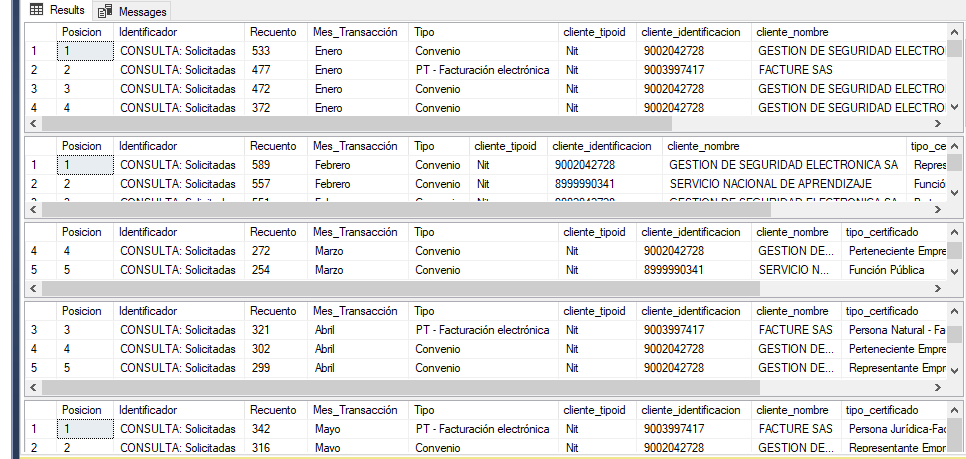Tengo una consulta que utiliza un ciclo while para arrojarme un top 10 de clientes con mas solicitudes por cada mes.
use
[GSEControl]
go
DECLARE @i INT, @mes int;
SET @i =1
SET @mes = 12
WHILE @i <= @mes
BEGIN (
SELECT TOP (10)
ROW_NUMBER () OVER (order by count(distinct CE.ContratoEjecucionId) desc) as Posicion,
'CONSULTA: Solicitadas' as Identificador,
count(distinct CE.ContratoEjecucionId ) Recuento,
case DATEPART(MONTH, CCE.fechahora )
when 1 then 'Enero'
when 2 then 'Febrero'
when 3 then 'Marzo'
when 4 then 'Abril'
when 5 then 'Mayo'
when 6 then 'Junio'
when 7 then 'Julio'
when 8 then 'Agosto'
when 9 then 'Septiembre'
when 10 then 'Octubre'
when 11 then 'Noviembre'
when 12 then 'Diciembre'
end as Mes_Transacción,
--cliente
case
when C.Tipo='C' then 'Convenio'
when C.Tipo='V' then 'Venta Call'
when C.Tipo='K' then 'VinKel'
when C.Tipo='P' then 'PT - Facturación electrónica'
when C.Tipo='D' and C.SuperContratoId=1 then 'DIAN'
when C.Tipo='D' and C.SuperContratoId=3 then 'Colfactura'
else 'Otro tipo' end as Tipo,
CL.TipoIdentificacionId as cliente_tipoid,
CL.TerceroId as cliente_identificacion,
ltrim(upper(coalesce(CL.RazonSocial,concat(CL.PrimerApellido, coalesce(' ' + CL.SegundoApellido + ' ', ' '),CL.PrimerNombre, coalesce(' ' + CL.SegundoNombre, ''))))) as cliente_nombre,
-- SERVICIO CONTRATADO
TC.Nombre as tipo_certificado,
TD.Nombre as tipo_emision
from
ContratoEjecucion as CE with(nolock)
left join ContratoServicio CS with(nolock) on ( CS.ContratoServicioId = CE.ContratoServicioId )
left join Contrato C with(nolock) on ( C.ContratoId = CS.ContratoId )
left join TipoCertificado TC with(nolock) on ( TC.TipoServicioId = CS.TipoServicioId and TC.TipoCertificadoId = CS.TipoCertificadoId )
left join TipoDispositivo TD with(nolock) on ( TD.TipoDispositivoId = CS.TipoDispositivoId )
left join Tercero CL with(nolock) on ( CL.TerceroId = C.Cliente )
left join Tercero SU with(nolock) on ( CE.Suscriptor = SU.TerceroId )
left join EstadoServicio ES with(nolock) on ( ES.EstadoServicioId = CE.EstadoServicioId )
left join Certificado CR with(nolock) on ( CR.ContratoEjecucionId = CE.ContratoEjecucionId )
left join ContratoEjecucionEstado CCE with(nolock) on (CE.ContratoEjecucionId=CCE.contratoejecucionid)
left join UsuarioDatoAdicional UDA with(nolock) on (UDA.UserId = CCE.Gestor)
where DATEPART(MONTH, CCE.fechahora ) = @i
group by
CL.TerceroId,
C.Tipo,
C.SuperContratoId,
CL.TipoIdentificacionId,
ltrim(upper(coalesce(CL.RazonSocial,concat(CL.PrimerApellido, coalesce(' ' + CL.SegundoApellido + ' ', ' '),CL.PrimerNombre, coalesce(' ' + CL.SegundoNombre, ''))))),
TC.Nombre,
TD.Nombre,
DATEPART(MONTH, CCE.fechahora )
)
set @i = @i + 1;
END;
Pero necesito que las tablas que me arroja la consulta esten agrupados en una sola:
Para esto leei varios foros y termine por decantarme a usar un CURSOR
use
[GSEControl]
go
DECLARE @Resultados as TABLE (Posicion BIGINT,Identificador text, Recuento INT,Mes_Transacción INT, Tipo text, cliente_tipoid text, cliente_identificacion int, cliente_nombre text, tipo_certificado text,tipo_emision text);
DECLARE Product_Cursor CURSOR FOR SELECT * FROM @Resultados;
DECLARE @i INT, @mes int;
SET @i =1
SET @mes = 12
OPEN Product_Cursor;
FETCH NEXT FROM Product_Cursor;
WHILE @i <= @mes and @@FETCH_STATUS = 0
BEGIN insert into @Resultados (
SELECT TOP (10)
ROW_NUMBER () OVER (order by count(distinct CE.ContratoEjecucionId) desc) as Posicion,
'CONSULTA: Solicitadas' as Identificador,
count(distinct CE.ContratoEjecucionId ) Recuento,
case DATEPART(MONTH, CCE.fechahora )
when 1 then 'Enero'
when 2 then 'Febrero'
when 3 then 'Marzo'
when 4 then 'Abril'
when 5 then 'Mayo'
when 6 then 'Junio'
when 7 then 'Julio'
when 8 then 'Agosto'
when 9 then 'Septiembre'
when 10 then 'Octubre'
when 11 then 'Noviembre'
when 12 then 'Diciembre'
end as Mes_Transacción,
--cliente
case
when C.Tipo='C' then 'Convenio'
when C.Tipo='V' then 'Venta Call'
when C.Tipo='K' then 'VinKel'
when C.Tipo='P' then 'PT - Facturación electrónica'
when C.Tipo='D' and C.SuperContratoId=1 then 'DIAN'
when C.Tipo='D' and C.SuperContratoId=3 then 'Colfactura'
else 'Otro tipo' end as Tipo,
CL.TipoIdentificacionId as cliente_tipoid,
CL.TerceroId as cliente_identificacion,
ltrim(upper(coalesce(CL.RazonSocial,concat(CL.PrimerApellido, coalesce(' ' + CL.SegundoApellido + ' ', ' '),CL.PrimerNombre, coalesce(' ' + CL.SegundoNombre, ''))))) as cliente_nombre,
-- SERVICIO CONTRATADO
TC.Nombre as tipo_certificado,
TD.Nombre as tipo_emision
from
ContratoEjecucion as CE with(nolock)
left join ContratoServicio CS with(nolock) on ( CS.ContratoServicioId = CE.ContratoServicioId )
left join Contrato C with(nolock) on ( C.ContratoId = CS.ContratoId )
left join TipoCertificado TC with(nolock) on ( TC.TipoServicioId = CS.TipoServicioId and TC.TipoCertificadoId = CS.TipoCertificadoId )
left join TipoDispositivo TD with(nolock) on ( TD.TipoDispositivoId = CS.TipoDispositivoId )
left join Tercero CL with(nolock) on ( CL.TerceroId = C.Cliente )
left join Tercero SU with(nolock) on ( CE.Suscriptor = SU.TerceroId )
left join EstadoServicio ES with(nolock) on ( ES.EstadoServicioId = CE.EstadoServicioId )
left join Certificado CR with(nolock) on ( CR.ContratoEjecucionId = CE.ContratoEjecucionId )
left join ContratoEjecucionEstado CCE with(nolock) on (CE.ContratoEjecucionId=CCE.contratoejecucionid)
left join UsuarioDatoAdicional UDA with(nolock) on (UDA.UserId = CCE.Gestor)
where DATEPART(MONTH, CCE.fechahora ) = @i
group by
CL.TerceroId,
C.Tipo,
C.SuperContratoId,
CL.TipoIdentificacionId,
ltrim(upper(coalesce(CL.RazonSocial,concat(CL.PrimerApellido, coalesce(' ' + CL.SegundoApellido + ' ', ' '),CL.PrimerNombre, coalesce(' ' + CL.SegundoNombre, ''))))),
TC.Nombre,
TD.Nombre,
DATEPART(MONTH, CCE.fechahora )
)
set @i = @i + 1;
FETCH NEXT FROM Product_Cursor;
END;
CLOSE Product_Cursor;
DEALLOCATE Product_Cursor;
pero obtengo un error "Msg 156, Level 15, State 1, Line 21 Incorrect syntax near the keyword 'SELECT'. Msg 102, Level 15, State 1, Line 86 Incorrect syntax near ')'."
Tambien intete cambiando la linea 20 porBEGIN set @Resultados = (
pero obtengo el error:
"Msg 137, Level 16, State 1, Line 20
Must declare the scalar variable "@Resultados"."
Si alguien me puede explicar por favor donde estoy aplicando mal el CURSOR o donde esta la falla en la lógica de esta consulta seria de mucha ayuda.
